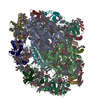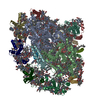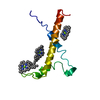[English] 日本語
 Yorodumi
Yorodumi- PDB-7ku5: The Structure of the moss PSI-LHCI reveals the evolution of the L... -
+ Open data
Open data
- Basic information
Basic information
| Entry | Database: PDB / ID: 7ku5 | ||||||
|---|---|---|---|---|---|---|---|
| Title | The Structure of the moss PSI-LHCI reveals the evolution of the LHCI antenna | ||||||
 Components Components | PsaO | ||||||
 Keywords Keywords | PHOTOSYNTHESIS / PSI / electron transport / chlorophyll / Antenna / light harvesting / membrane protein | ||||||
| Function / homology | Photosystem I PsaO / PsaO transmembrane domain / membrane / BETA-CAROTENE / CHLOROPHYLL A / Photosystem I subunit O Function and homology information Function and homology information | ||||||
| Biological species |  Physcomitrium patens (plant) Physcomitrium patens (plant) | ||||||
| Method | ELECTRON MICROSCOPY / single particle reconstruction / cryo EM / Resolution: 3.76 Å | ||||||
 Authors Authors | Riddle, R. / Gorski, C. / Toporik, H. / Dobson, Z. / Da, Z. / Williams, D. / Mazor, Y. | ||||||
| Funding support | 1items
| ||||||
 Citation Citation |  Journal: Nat Plants / Year: 2022 Journal: Nat Plants / Year: 2022Title: The structure of the Physcomitrium patens photosystem I reveals a unique Lhca2 paralogue replacing Lhca4. Authors: C Gorski / R Riddle / H Toporik / Z Da / Z Dobson / D Williams / Y Mazor /  Abstract: The moss Physcomitrium patens diverged from green algae shortly after the colonization of land by ancient plants. This colonization posed new environmental challenges, which drove evolutionary ...The moss Physcomitrium patens diverged from green algae shortly after the colonization of land by ancient plants. This colonization posed new environmental challenges, which drove evolutionary processes. The photosynthetic machinery of modern flowering plants is adapted to the high light conditions on land. Red-shifted Lhca4 antennae are present in the photosystem I light-harvesting complex of many green-lineage plants but absent in P. patens. The cryo-EM structure of the P. patens photosystem I light-harvesting complex I supercomplex (PSI-LHCI) at 2.8 Å reveals that Lhca4 is replaced by a unique Lhca2 paralogue in moss. This PSI-LHCI supercomplex also retains the PsaM subunit, present in Cyanobacteria and several algal species but lost in vascular plants, and the PsaO subunit responsible for binding light-harvesting complex II. The blue-shifted Lhca2 paralogue and chlorophyll b enrichment relative to flowering plants make the P. patens PSI-LHCI spectroscopically unique among other green-lineage supercomplexes. Overall, the structure represents an evolutionary intermediate PSI with the crescent-shaped LHCI common in vascular plants, and contains a unique Lhca2 paralogue that facilitates the moss's adaptation to low-light niches. | ||||||
| History |
|
- Structure visualization
Structure visualization
| Structure viewer | Molecule:  Molmil Molmil Jmol/JSmol Jmol/JSmol |
|---|
- Downloads & links
Downloads & links
- Download
Download
| PDBx/mmCIF format |  7ku5.cif.gz 7ku5.cif.gz | 32 KB | Display |  PDBx/mmCIF format PDBx/mmCIF format |
|---|---|---|---|---|
| PDB format |  pdb7ku5.ent.gz pdb7ku5.ent.gz | 17.6 KB | Display |  PDB format PDB format |
| PDBx/mmJSON format |  7ku5.json.gz 7ku5.json.gz | Tree view |  PDBx/mmJSON format PDBx/mmJSON format | |
| Others |  Other downloads Other downloads |
-Validation report
| Arichive directory |  https://data.pdbj.org/pub/pdb/validation_reports/ku/7ku5 https://data.pdbj.org/pub/pdb/validation_reports/ku/7ku5 ftp://data.pdbj.org/pub/pdb/validation_reports/ku/7ku5 ftp://data.pdbj.org/pub/pdb/validation_reports/ku/7ku5 | HTTPS FTP |
|---|
-Related structure data
| Related structure data |  23034MC  7ksqC  7kuxC C: citing same article ( M: map data used to model this data |
|---|---|
| Similar structure data | Similarity search - Function & homology  F&H Search F&H Search |
- Links
Links
- Assembly
Assembly
| Deposited unit | 
|
|---|---|
| 1 |
|
- Components
Components
| #1: Protein | Mass: 9778.286 Da / Num. of mol.: 1 / Source method: isolated from a natural source / Source: (natural)  Physcomitrium patens (plant) / References: UniProt: A0A2K1JDE1 Physcomitrium patens (plant) / References: UniProt: A0A2K1JDE1 | ||||
|---|---|---|---|---|---|
| #2: Chemical | | #3: Chemical | ChemComp-BCR / | Has ligand of interest | Y | |
-Experimental details
-Experiment
| Experiment | Method: ELECTRON MICROSCOPY |
|---|---|
| EM experiment | Aggregation state: PARTICLE / 3D reconstruction method: single particle reconstruction |
- Sample preparation
Sample preparation
| Component | Name: PSI / Type: COMPLEX / Entity ID: #1 / Source: NATURAL |
|---|---|
| Source (natural) | Organism:  Physcomitrium patens (plant) Physcomitrium patens (plant) |
| Buffer solution | pH: 8 |
| Specimen | Embedding applied: NO / Shadowing applied: NO / Staining applied: NO / Vitrification applied: YES |
| Vitrification | Cryogen name: ETHANE |
- Electron microscopy imaging
Electron microscopy imaging
| Experimental equipment |  Model: Titan Krios / Image courtesy: FEI Company |
|---|---|
| Microscopy | Model: FEI TITAN KRIOS |
| Electron gun | Electron source:  FIELD EMISSION GUN / Accelerating voltage: 300 kV / Illumination mode: FLOOD BEAM FIELD EMISSION GUN / Accelerating voltage: 300 kV / Illumination mode: FLOOD BEAM |
| Electron lens | Mode: BRIGHT FIELD |
| Image recording | Electron dose: 1.6 e/Å2 / Film or detector model: GATAN K2 SUMMIT (4k x 4k) |
- Processing
Processing
| EM software | Name: RELION / Version: 3.1 / Category: final Euler assignment |
|---|---|
| CTF correction | Type: PHASE FLIPPING AND AMPLITUDE CORRECTION |
| 3D reconstruction | Resolution: 3.76 Å / Resolution method: FSC 0.143 CUT-OFF / Num. of particles: 15357 / Symmetry type: POINT |
 Movie
Movie Controller
Controller




 PDBj
PDBj








